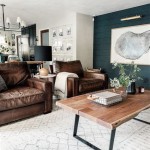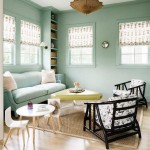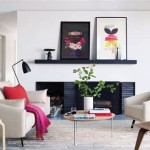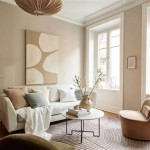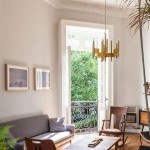Transforming Small Living Rooms: Interior Design Strategies for Maximizing Space and Style
Small living rooms present unique design challenges. The objective is to create a space that is both functional and aesthetically pleasing, despite limitations in square footage. Effective interior design for small living rooms necessitates careful planning, strategic furniture selection, and thoughtful utilization of color and light. The principles outlined in this article offer a comprehensive guide to optimizing the design of compact living areas, focusing on maximizing space, enhancing visual appeal, and creating a comfortable and inviting atmosphere. The goal is to transform a potentially cramped and uninspired room into a stylish and functional hub of the home.
The initial phase of any small living room design project involves a thorough assessment of the existing space. This includes accurately measuring the room's dimensions, noting the location of windows and doors, and identifying any architectural features that might impact the design. Understanding the room's natural light sources is crucial for determining the appropriate color palette and lighting scheme. Furthermore, clarifying the intended function of the living room is paramount. Will it primarily serve as a space for relaxation and entertainment? Or will it also need to accommodate activities such as reading, working, or even dining? Defining the room's purpose will greatly influence furniture selection and layout.
Strategic Furniture Selection for Limited Spaces
Furniture selection is arguably the most critical aspect of small living room design. The key is to choose pieces that are appropriately scaled to the room's dimensions, avoiding bulky or oversized items that can overwhelm the space. Multifunctional furniture is particularly valuable in small living rooms, as it can serve multiple purposes and reduce the overall clutter. Examples of multifunctional furniture include sofa beds, ottomans with built-in storage, and coffee tables with lift-top features.
When selecting a sofa, consider a smaller scale model or a loveseat rather than a large sectional. Sectional sofas, while comfortable, often consume a significant amount of floor space, making them unsuitable for small living rooms. A sofa with slim arms and exposed legs will create a more open and airy feel. Likewise, avoid overly plush or heavily padded sofas, as these can appear visually bulky.
Chairs should also be chosen with careful consideration. Instead of opting for large, armchairs, consider smaller, more streamlined designs. Armless chairs or accent chairs with slender frames can provide comfortable seating without taking up excessive space. Clear acrylic chairs are also an excellent option, as they visually disappear and create the illusion of more space. A single statement chair can add personality and interest to the room without crowding the space.
Coffee tables are another area where strategic selection is important. A coffee table with hidden storage is ideal for stowing away items such as magazines, remote controls, or blankets. Consider a coffee table with a lift-top feature, which can be used as a temporary work surface or dining table. Alternatively, a set of nesting tables can be a space-saving solution, as they can be easily pulled out when needed and stored away when not in use. Avoid large, solid coffee tables, as these can create a visual barrier and make the room feel smaller. Opt for a coffee table with a glass top or a light-colored finish to enhance the sense of openness.
Maximizing Space Through Layout and Organization
The layout of furniture is crucial for optimizing space in a small living room. The goal is to create a functional and inviting arrangement that allows for easy movement and maximum utilization of the available square footage. Start by identifying the focal point of the room, which is often a fireplace, a large window, or a television. Arrange the furniture around this focal point to create a cohesive and balanced composition.
Avoid pushing all the furniture against the walls. This common mistake can actually make the room feel smaller and less inviting. Instead, create small pockets of space by angling furniture slightly or leaving a few inches of space between the furniture and the walls. This will create a more dynamic and visually appealing layout. In a small living room, floating furniture can make the space feel bigger.
Vertical space is often underutilized in small living rooms. Install shelves or bookcases to take advantage of the vertical dimension. Shelves can be used to display books, artwork, and decorative objects, adding personality and visual interest to the room. Choose shelves that are light and airy, avoiding bulky or heavy designs. A tall bookcase can serve as a room divider, creating a sense of separation between the living room and other areas of the home. Installing floating shelves is another good way to save space in a room.
Effective organization is essential for maintaining a clutter-free and spacious living room. Invest in storage solutions such as baskets, bins, and decorative boxes to keep items organized and out of sight. A media console with ample storage space can help conceal electronic devices and cables. Regularly declutter the living room to remove any unnecessary items that are taking up space. A minimalist approach to decor will help create a more open and airy feel.
Color and Light: Creating a Sense of Spaciousness
The choice of color and lighting can significantly impact the perceived size and atmosphere of a small living room. Light colors tend to reflect more light, making the room feel brighter and more spacious. Opt for a neutral color palette, such as white, beige, gray, or pale pastels, for the walls and larger furniture pieces. These colors create a clean and airy backdrop that allows other elements of the room to stand out.
Avoid using dark or saturated colors on the walls, as these can absorb light and make the room feel smaller and more enclosed. If using dark colors, consider using them as accents rather than as the primary wall color. A dark accent wall can add drama and visual interest without overwhelming the space. Another way to use color strategically is to paint the ceiling a lighter shade than the walls. This will create the illusion of a higher ceiling and make the room feel more spacious.
Natural light is crucial for creating a bright and inviting living room. Maximize natural light by keeping windows clear and unobstructed. Avoid using heavy curtains or blinds that block out sunlight. Instead, opt for sheer curtains or blinds that allow light to filter through while still providing privacy. Mirrors are also an excellent way to enhance natural light in a small living room. Place a large mirror on a wall opposite a window to reflect light and create the illusion of more space.
Artificial lighting is equally important, especially in rooms with limited natural light. Layering different types of lighting is a key principle of effective small living room design. Incorporate ambient lighting, task lighting, and accent lighting to create a balanced and functional lighting scheme. Ambient lighting provides overall illumination for the room, while task lighting is used for specific activities such as reading or working. Accent lighting is used to highlight certain features or objects in the room, such as artwork or architectural details.
Floor lamps are an excellent way to add ambient light without taking up valuable floor space. Choose a floor lamp with a slim profile to avoid overcrowding the room. Table lamps can be used to provide task lighting and add a decorative touch. Consider using lamps with adjustable arms or dimmers to customize the lighting to different needs. Recessed lighting is another space-saving option for providing ambient light. Track lighting can be used to highlight specific areas or objects in the room.
Careful consideration of furniture selection, layout, color, and lighting are essential for transforming small living rooms into functional and stylish spaces. By employing these design strategies, it is possible to maximize space, enhance visual appeal, and create a comfortable and inviting atmosphere, even in the most compact of living areas. The emphasis on strategic planning, multifunctional furniture, and intelligent use of color and light empowers individuals to create a living room that is both aesthetically pleasing and practical for everyday living.

10 Stunning Small Living Room Ideas To Maximize Space

55 Small Living Room Ideas For Compact Spaces House Garden

31 Stunning Small Living Room Ideas
:max_bytes(150000):strip_icc()/241791572_212003384294928_1925123565378044744_n-3dceead11099472ca283f51eea10a0f3.jpg?strip=all)
46 Small Living Room Ideas To Maximize Space And Style
:strip_icc()/cdn.cliqueinc.com__cache__posts__277814__how-to-decorate-a-small-living-room-277814-1551117587765-main.700x0c-4309ac2c88e045309331c6a3488108f1.jpg?strip=all)
How To Decorate A Small Living Room In 6 Steps

80 Gorgeous Living Room Decorating Ideas For Every Style

18 Small Living Room Design Ideas To Transform Your Space

80 Gorgeous Living Room Decorating Ideas For Every Style

7 Small Living Room Design Ideas Oppein

15 Apartment Living Room Design Ideas And Examples

